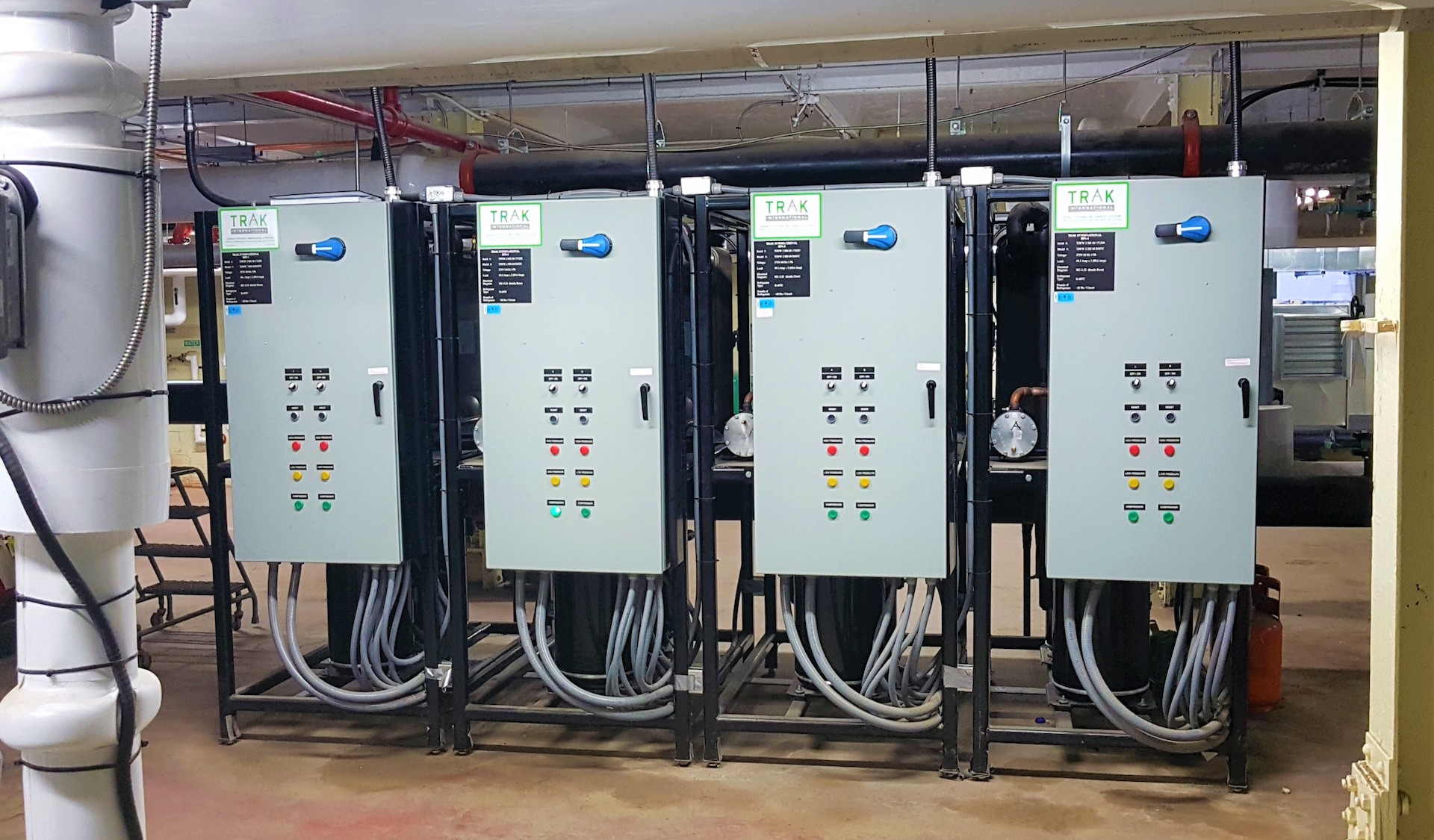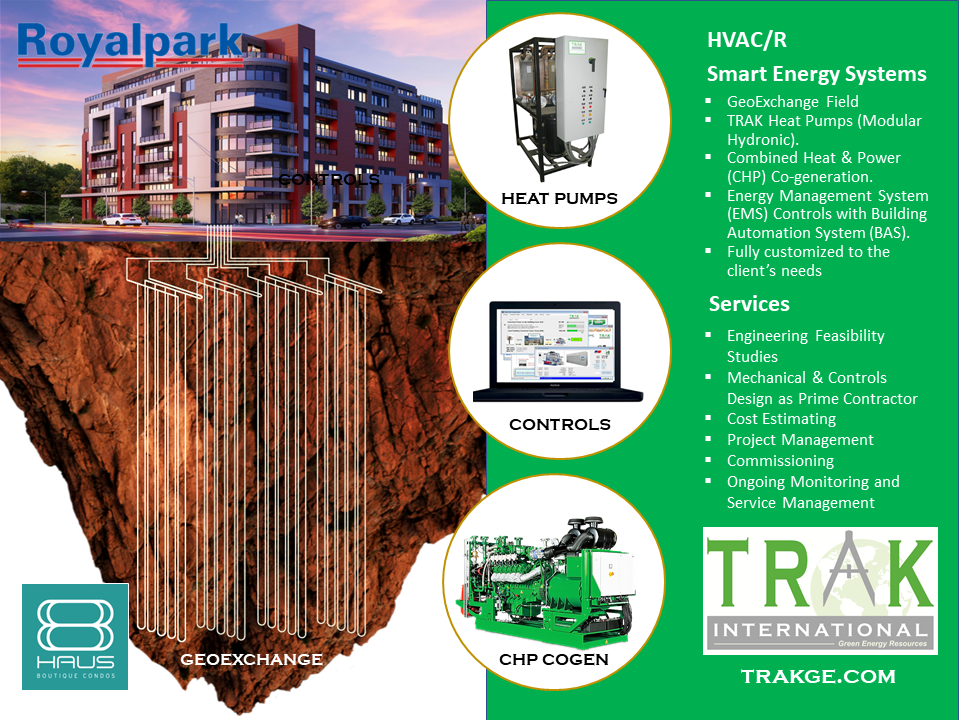8 Haus: Smart Energy System Model Project

Projects Sponsor
Building a Green Future: TRAK International Green Energy Resources’ Smart Energy System Model Project lays the foundation for efficient development.
Concerned about global warming, escalating energy costs, and recognizing the extraordinary and innovative opportunities provided by modern technology, TRAK International Green Energy Resources Inc. decided that the construction industry needed to up its game. It was clear to TRAK that it was high time and prime time to build safer, resilient, and sustainable living spaces and that this could be done cost-effectively.
TRAK set out not just to build better but to do it in a way that’s better for everyone concerned. The end owners’ living space quality and long-term energy and maintenance costs were front and center in everyone’s minds during the design and construction of the 8 Haus project. With the one hundred unit 8 Haus, TRAK aimed to set a very high sustainability standard and have it recognized in the fixed, affordable sale price to new home purchasers.
TRAK and Royalpark Homes’ plan to build safer, resilient, and sustainable living spaces cost-effectively began in 2014, but before the project was fully launched, meetings were held to confirm the team’s compatibility and ensure there was both a shared sustainability culture and the requisite practical experience. The 8 Haus project already had completed architectural, mechanical, and electrical design drawings that followed a less desired conventional practice; TRAK’s work was laid out for them.
Existing site studies were reviewed, and TRAK researched nearby well records from the Ontario Ministry of the Environment to predict the ground drilling conditions and thermal capacitance of a potential geoexchange energy field. They reviewed the complete design and specifications, identified gaps in building safety, modelled and refined alternative methods for heating, heat recovery, space cooling, and checked grid capacity for on-site power generation. Budgets postulating different design solutions per their goals were prepared.
The researched modelling references guiding to the solutions included reviewing the Energy Efficiency Report Submission & Modelling guidelines of the Toronto Green Standard (TGS) Version 3.0, National Energy Code of Canada 2015 for Building-NRCAN, City of Toronto Zero Emissions Buildings Framework, MMA Supplementary Standard SB-10 Energy Efficiency Requirements, and other documents.

The conventional reference high-rise MURB type was modelled. The comparative TRAK Smart Energy System (SES) was modelled incorporating the unique geoexchange, centralized hydronic TRAK Heat Pumps, CHP on-site power generation, and TRAK customized energy management and controls features.
The resulting study found that the TRAK SES would significantly reduce energy use and cost, reduce GHG emissions, improve occupant safety, increase building power and heating resilience, and better preserve the structure and installed systems. The enhanced ventilation and pathogen mitigation methods would further contribute to healthier indoor environments. Individual suite metering accounts for specific hot-water and cold-water consumption, heating and cooling energy use, and electric vehicle charging particular and visible to users in real-time hold real promise for conservation. This research and the modelling results enabled green loan financing, advancing to detailed design and then linking to construction reality and competitive budgets.
A fresh, green approach to the design and construction of multi-unit dwellings meant addressing the uncertainties that come with reaching outside the “business-as-usual” box. It meant cutting through the noise made by the torrent of promotional advertising aimed at developers that can make it difficult for developers and purchasers to differentiate between truly green and energy-efficient building systems, and hokum.

TRAK’s commitment to their fact-based detailed engineering study and modelling helped alleviate those problems, and from their process, the successful Royalpark 8 Haus building rose. More than a hi-rise development, 8 Haus, becomes a living, lived-in testament to what can be built on the sustainability frontier. It is an empowered catalyst, highly repeatable, just about anywhere.
Through careful design, 8 Haus offsets ongoing annual energy costs around 47% and achieved an Energy Use Intensity and Green House Gas Intensity that exceeds the Toronto Green Standard v3 Tier 3 and Tier 2 requirements.
What TRAK offered with 8 Haus was a win-win, save energy proposition. They wanted to build resilient, sustainable housing, create purposeful employment and true prosperity while encouraging, enabling, and inspiring alternative energy graduates and conscientious designers, developers, and builders to do the same.
And they delivered and will again.
The TRAK design-build team and Royalpark are replicating and continually improving their 8 Haus Smart Energy System, scaling it up for current two hundred and three hundred-unit condo developments. The process is kept simple, straightforward, and cost-effective for developers. The team is building new relationships and working with other developers following their lead. A greener skyline is on the horizon.
















